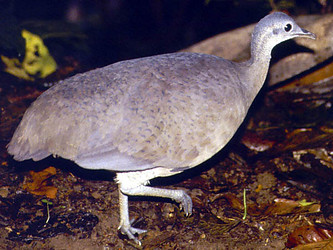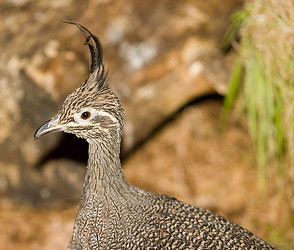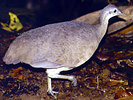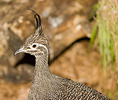Tinamiformes
Tinamidae, tinamous
Joseph W. Brown


This tree diagram shows the relationships between several groups of organisms.
The root of the current tree connects the organisms featured in this tree to their containing group and the rest of the Tree of Life. The basal branching point in the tree represents the ancestor of the other groups in the tree. This ancestor diversified over time into several descendent subgroups, which are represented as internal nodes and terminal taxa to the right.

You can click on the root to travel down the Tree of Life all the way to the root of all Life, and you can click on the names of descendent subgroups to travel up the Tree of Life all the way to individual species.
For more information on ToL tree formatting, please see Interpreting the Tree or Classification. To learn more about phylogenetic trees, please visit our Phylogenetic Biology pages.
close boxReferences
Bertelli, S. 2004. Pigmentation characters: An example of Sankoff characters from Tinamou phylogeny. Ornitología Neotropical 15: 285-291.
Bertelli, S., and A. L. Porzecanski. 2004. Tinamou (Tinamidae) systematics: a preliminary combined analysis of morphology and molecules. Ornitologia Neotropical 15 (Supp.): 1-8.
Bertelli, S., N. P. Giannini, and P. Goloboff. 2002. A phylogeny of the tinamous (Aves : Palaeognathiformes) based on integumentary characters. Systematic Biology 51: 959-979.
Bertelli, S., and P. L. Tubaro. 2002. Body mass and habitat correlates of song structure in a primitive group of birds. Biological Journal of the Linnean Society 77: 423-430.
von Boettischer, H. 1934. Beiträage zu einem phylogentisch begründeten natürlichen System der Steisshühner (Tinami) auf Grund einer taxonomisch verwertbaren Charaktere. Jena Z. Naturwiss. 69:169–192.
Cabot, J. 1992. Order Tinamiformes. Pp 112–138 in del Hoyo, J., A. Elliot, and J. Sargatal (eds.), Handbook of the birds of the world. Volume 1. Lynx Edicions, Barcelona.
Davies, S. J. J. F. 2002. Ratites and Tinamous. Oxford University Press, New York.
De Kloet, S. R. 2002. Molecular sex identification of tinamous with PCR using primers derived from the spindlin gene. Molecular Ecology Notes 2: 465-466.
De Kloet, R. S., and S. R. De Kloet. 2003. Evolution of the spindlin gene in birds: independent cessation of the recombination of sex chromosomes at the spindlin locus in neognathous birds and tinamous, a palaeognathous avian family. Genetica 119: 333-342.
Gill, F. and M. Wright. 2006. Birds of the World: Recommended English Names. Princeton NJ: Princeton University Press.
Jehl, J. R., Jr. 1971. The color patterns of downy young ratites and tinamous. Trans. San Diego Soc. Nat. Hist. 16:292–301.
Maijer, S. 1996. Distinctive song of highland form maculicollis of the Red-winged Tinamou (Rhynchotus rufescens): Evidence for species rank. Auk 113: 695-697.
Miranda-Ribeiro, A. de. 1938. Notas ornithológicas, Tinamidae. Rev. Mus. Paulista 23:667–788.
Salvadori, T. 1895. Catalogue of the Chenomorphe (Palamedeae, Phoenicopteri, Anseres), Cryturi, and Ratitae in the collection of the British Museum. British Museum (Natural History), London.
Tubaro, P. L., and S. Bertelli. 2003. Female-biased sexual size dimorphism in tinamous: a comparative test fails to support Rensch's rule. Biological Journal of the Linnean Society 80: 519-527.
Ward, R. A. 1957. A study of the host distribution and some relationships of Mallophaga parasites on birds on the order Tinamiformes. Part I. Ann. Entonol. Soc. Am. 50:335–353.
Withers, P. C., R. B. Forbes, and M. S. Hedrick. 1987. Metabolic, water, and thermal relations of the Chilean Tinamou. Condor 89: 424-426.
Title Illustrations

| Scientific Name | Tinamus major |
|---|---|
| Location | La Selva Biological Station, Saripiqui, Costa Rica |
| Specimen Condition | Live Specimen |
| Source | Great Tinamou |
| Source Collection | Flickr |
| Image Use |
 This media file is licensed under the Creative Commons Attribution-NonCommercial-NoDerivs License - Version 2.0. This media file is licensed under the Creative Commons Attribution-NonCommercial-NoDerivs License - Version 2.0.
|
| Copyright |
© 1992 Patrick Coin

|
| Scientific Name | Eudromia elegans |
|---|---|
| Location | Roger Williams Zoo, Providence, Rhode Island, USA |
| Specimen Condition | Live Specimen |
| Source | Tina Who? |
| Source Collection | Flickr |
| Image Use |
 This media file is licensed under the Creative Commons Attribution-NonCommercial-ShareAlike License - Version 2.0. This media file is licensed under the Creative Commons Attribution-NonCommercial-ShareAlike License - Version 2.0.
|
| Copyright | © 2006 Eric Heupel |
About This Page
Joseph W. Brown

University of Michigan Museum of Zoology, Ann Arbor, Michigan, USA
Correspondence regarding this page should be directed to Joseph W. Brown at
Page copyright © 2010 Joseph W. Brown
 Page: Tree of Life
Tinamiformes. Tinamidae, tinamous.
Authored by
Joseph W. Brown.
The TEXT of this page is licensed under the
Creative Commons Attribution-NonCommercial License - Version 3.0. Note that images and other media
featured on this page are each governed by their own license, and they may or may not be available
for reuse. Click on an image or a media link to access the media data window, which provides the
relevant licensing information. For the general terms and conditions of ToL material reuse and
redistribution, please see the Tree of Life Copyright
Policies.
Page: Tree of Life
Tinamiformes. Tinamidae, tinamous.
Authored by
Joseph W. Brown.
The TEXT of this page is licensed under the
Creative Commons Attribution-NonCommercial License - Version 3.0. Note that images and other media
featured on this page are each governed by their own license, and they may or may not be available
for reuse. Click on an image or a media link to access the media data window, which provides the
relevant licensing information. For the general terms and conditions of ToL material reuse and
redistribution, please see the Tree of Life Copyright
Policies.
- First online 19 December 2005
- Content changed 07 March 2007
Citing this page:
Brown, Joseph W. 2007. Tinamiformes. Tinamidae, tinamous. Version 07 March 2007 (temporary). http://tolweb.org/Tinamiformes/15838/2007.03.07 in The Tree of Life Web Project, http://tolweb.org/









 Go to quick links
Go to quick search
Go to navigation for this section of the ToL site
Go to detailed links for the ToL site
Go to quick links
Go to quick search
Go to navigation for this section of the ToL site
Go to detailed links for the ToL site